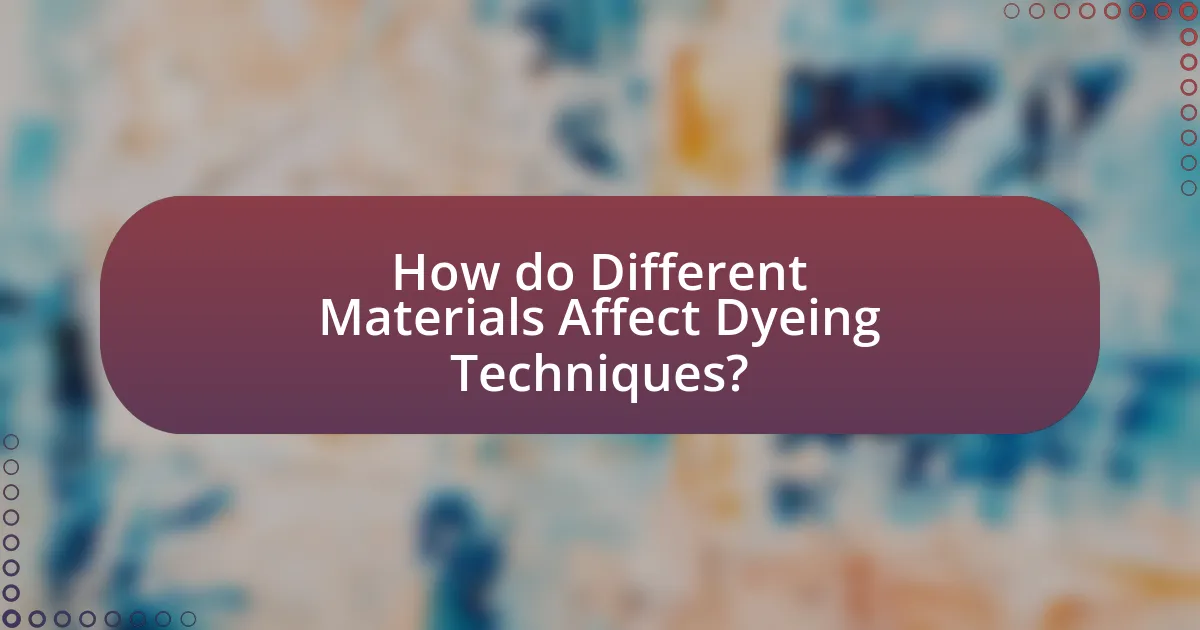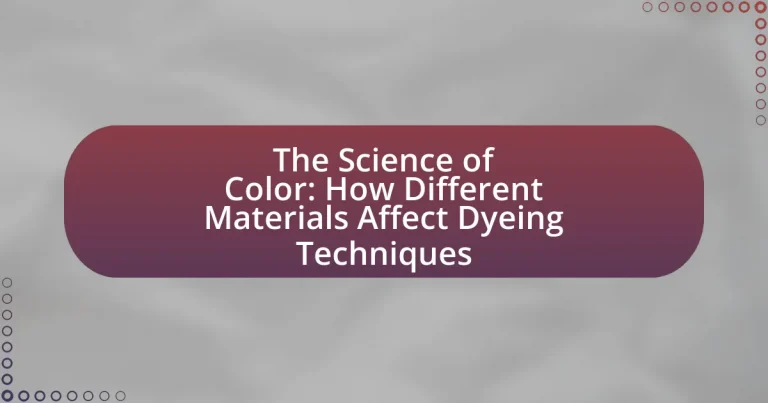The article focuses on the science of color in dyeing techniques, examining how various materials interact with dyes to produce specific colors. It explores the chemical and physical properties of natural and synthetic fibers, detailing how these characteristics influence dye absorption, colorfastness, and overall appearance. Key topics include the principles of color theory, the impact of light and perception on color, and the importance of understanding material properties in achieving optimal dyeing results. Additionally, the article discusses practical applications of dyeing techniques across different industries and provides best practices for selecting dyes and troubleshooting common dyeing issues.

What is the Science of Color in Dyeing Techniques?
The science of color in dyeing techniques involves understanding how different materials interact with dyes to produce specific colors. This interaction is influenced by the chemical composition of the dye, the properties of the material being dyed, and the dyeing process itself. For example, natural fibers like cotton and wool absorb dyes differently due to their molecular structure, which can lead to variations in color intensity and shade. Additionally, the pH level of the dye bath can alter the final color, as certain dyes are pH-sensitive. Research indicates that the use of mordants, which are substances that fix dyes to fibers, can enhance color vibrancy and longevity, demonstrating the complex relationship between materials and dyeing techniques.
How do colors interact with different materials during dyeing?
Colors interact with different materials during dyeing through chemical and physical processes that affect color absorption and retention. For instance, natural fibers like cotton and wool absorb dyes more effectively due to their porous structure and the presence of hydroxyl groups that form hydrogen bonds with dye molecules. In contrast, synthetic fibers such as polyester require specific dye types, like disperse dyes, because their non-polar structure limits dye uptake. Studies show that the dyeing process can be influenced by factors such as temperature, pH, and the presence of mordants, which can enhance color fixation on the material. For example, using a mordant like alum can increase the vibrancy and longevity of colors on wool, demonstrating the significant role of material properties in dyeing outcomes.
What are the fundamental principles of color theory in dyeing?
The fundamental principles of color theory in dyeing include the color wheel, color harmony, and the interaction of colors. The color wheel organizes colors into primary, secondary, and tertiary categories, which helps dyers understand how colors relate to one another. Color harmony refers to the aesthetically pleasing combinations of colors, such as complementary, analogous, and triadic schemes, guiding dyers in creating visually appealing results. Additionally, the interaction of colors, including concepts like color mixing and the effects of light on color perception, is crucial in dyeing processes, as different materials can absorb and reflect colors differently, impacting the final outcome.
How do light and perception influence color in dyed materials?
Light and perception significantly influence the color of dyed materials by affecting how colors are seen and interpreted. The interaction of light with the dye molecules determines the wavelengths that are absorbed and reflected, which in turn influences the perceived color. For instance, dyed fabrics may appear different under various lighting conditions, such as natural sunlight versus artificial light, due to the spectrum of light emitted by these sources. Additionally, human perception plays a crucial role; factors such as surrounding colors, the observer’s vision, and even cultural context can alter the interpretation of the color. Research indicates that colors can look different based on the observer’s environment and the light’s quality, demonstrating the complex relationship between light, perception, and color in dyed materials.
Why is understanding material properties important in dyeing?
Understanding material properties is crucial in dyeing because it directly influences the dye’s absorption, colorfastness, and overall appearance on the fabric. Different materials, such as cotton, silk, and polyester, have unique chemical structures that affect how dyes interact with them. For instance, natural fibers like cotton have hydroxyl groups that bond well with reactive dyes, resulting in vibrant colors, while synthetic fibers may require specific dyes to achieve similar results. Studies show that the dyeing process can vary significantly based on the material’s properties, with cotton typically achieving higher color retention compared to polyester, which may fade more quickly. Therefore, knowledge of material properties enables dyers to select appropriate dyes and techniques, ensuring optimal results in color application and longevity.
What physical and chemical properties of materials affect dye uptake?
The physical and chemical properties of materials that affect dye uptake include porosity, surface area, chemical composition, and pH. Porosity influences how much dye can penetrate the material, with more porous materials allowing greater dye absorption. Surface area affects the interaction between the dye and the material; larger surface areas typically lead to higher dye uptake due to increased contact. The chemical composition, including the presence of functional groups, determines the affinity of the dye for the material, as certain dyes bond more effectively with specific chemical structures. pH can alter the charge of the material and the dye, impacting solubility and interaction, which ultimately influences dye uptake. For example, studies have shown that cotton, which has a high surface area and specific functional groups, exhibits significant dye uptake compared to synthetic fibers with lower porosity and different chemical properties.
How do fiber types influence dyeing results?
Fiber types significantly influence dyeing results due to their chemical structure and affinity for different dyes. Natural fibers like cotton and wool typically absorb dyes more readily than synthetic fibers such as polyester, which often require specific dyeing processes due to their hydrophobic nature. For instance, cotton, being hydrophilic, can easily bond with reactive dyes, resulting in vibrant colors, while polyester may need disperse dyes and higher temperatures to achieve similar results. This variance in dye uptake is supported by studies showing that the molecular composition of fibers directly affects dye interaction, leading to differences in colorfastness and shade intensity.

How do Different Materials Affect Dyeing Techniques?
Different materials significantly influence dyeing techniques due to their unique chemical and physical properties. For instance, natural fibers like cotton and wool absorb dyes more readily than synthetic fibers such as polyester, which often require specific dyeing methods like disperse dyeing. The structure of the material affects dye uptake; for example, the porous nature of cotton allows for deeper penetration of dye molecules, resulting in vibrant colors. Conversely, synthetic fibers may need pre-treatment to enhance dye affinity, as their smooth surfaces can repel dye. Additionally, the pH level of the dye bath can interact differently with various materials, affecting the final color outcome. Studies have shown that the dyeing process for wool can yield richer hues compared to nylon due to wool’s ability to form hydrogen bonds with dye molecules, enhancing color retention.
What are the main types of materials used in dyeing?
The main types of materials used in dyeing are natural fibers, synthetic fibers, and dyes. Natural fibers, such as cotton, wool, and silk, are derived from plants and animals and have unique properties that affect dye absorption. Synthetic fibers, like polyester and nylon, are man-made and often require specific dyes for effective coloring. Dyes themselves can be categorized into natural dyes, sourced from plants and minerals, and synthetic dyes, which are chemically produced. The interaction between these materials influences the dyeing process and the final color outcome.
How do natural fibers compare to synthetic fibers in dyeing?
Natural fibers generally absorb dyes more effectively than synthetic fibers due to their porous structure and the presence of hydroxyl groups that facilitate bonding with dye molecules. For instance, cotton, a natural fiber, can achieve vibrant colors and deep saturation because it readily interacts with various dye types, including reactive and direct dyes. In contrast, synthetic fibers like polyester have a smoother surface and lack these functional groups, making them less receptive to dye absorption without the use of specialized dyeing techniques, such as disperse dyeing, which requires higher temperatures and pressure. Studies have shown that natural fibers can achieve higher color yield and better wash fastness compared to synthetic fibers, reinforcing the notion that the inherent properties of the fibers significantly influence dyeing outcomes.
What role do blends of materials play in dyeing outcomes?
Blends of materials significantly influence dyeing outcomes by affecting the absorption and retention of dyes. Different fibers, such as cotton, wool, and synthetic materials, have varying affinities for dyes, which can lead to distinct color results when blended. For instance, a cotton-wool blend may absorb dye differently than a pure cotton fabric, resulting in a unique shade or depth of color. Studies have shown that the chemical structure of the fibers determines how well they interact with specific dyes, impacting the final appearance and durability of the color. This variability is crucial for achieving desired aesthetic effects in textile design.
How do dyeing techniques vary with different materials?
Dyeing techniques vary significantly with different materials due to their unique chemical and physical properties. For instance, natural fibers like cotton and wool absorb dyes differently; cotton, being hydrophilic, requires a pre-treatment with mordants to enhance dye uptake, while wool can bond with dyes more readily due to its protein structure. Synthetic fibers, such as polyester, often necessitate specific dye types, like disperse dyes, because their non-polar nature resists traditional dyeing methods. Additionally, the dyeing temperature and time can differ; for example, higher temperatures are typically used for synthetic fibers to facilitate dye penetration. These variations are supported by studies indicating that the molecular structure of the material directly influences dye affinity and fixation, demonstrating the importance of material selection in dyeing processes.
What are the specific dyeing methods suitable for various materials?
Specific dyeing methods vary according to the material being dyed. For natural fibers like cotton and linen, methods such as direct dyeing and reactive dyeing are effective, as they allow for vibrant colors and good wash fastness. For protein fibers like wool and silk, acid dyeing is suitable, utilizing acidic conditions to achieve rich hues. Synthetic fibers, such as polyester and nylon, often require disperse dyeing, which uses high temperatures to facilitate dye absorption. Each method is tailored to the chemical structure of the material, ensuring optimal color uptake and durability.
How does the dyeing process change based on material characteristics?
The dyeing process varies significantly based on the characteristics of the material being dyed. For instance, natural fibers like cotton and wool absorb dyes differently than synthetic fibers such as polyester. Natural fibers typically have a higher affinity for dyes due to their porous structure, allowing for deeper penetration and more vibrant colors. In contrast, synthetic fibers often require specific dye types, such as disperse dyes, and may need additional heat or pressure to achieve effective color uptake. This difference is supported by the fact that natural fibers can form hydrogen bonds with dye molecules, enhancing color retention, while synthetic fibers lack this capability, necessitating alternative dyeing methods.

What are the Practical Applications of Dyeing Techniques?
Dyeing techniques have practical applications across various industries, including textiles, food, cosmetics, and art. In the textile industry, dyeing is essential for creating colorful fabrics, with methods such as reactive dyeing and vat dyeing being widely used to achieve vibrant and long-lasting colors. The food industry utilizes natural dyeing techniques to enhance the visual appeal of products, employing plant-based dyes like beetroot and turmeric for coloring. In cosmetics, dyeing techniques are applied to formulate products like hair dyes and makeup, ensuring a wide range of shades for consumers. Additionally, artists use dyeing techniques in fabric art and crafts, allowing for creative expression through color manipulation. These applications demonstrate the versatility and significance of dyeing techniques in enhancing aesthetics and functionality across multiple sectors.
How can one achieve the best results in dyeing different materials?
To achieve the best results in dyeing different materials, one must select the appropriate dye type and method based on the material’s composition. For example, natural fibers like cotton and wool absorb dyes differently than synthetic fibers such as polyester, requiring specific dyes like reactive dyes for cotton and disperse dyes for polyester. Additionally, pre-treatment processes, such as scouring and mordanting, enhance dye uptake and colorfastness. Research indicates that using the correct temperature and pH levels during the dyeing process can significantly impact the final color intensity and uniformity, as demonstrated in studies on dye absorption rates across various materials.
What tips can enhance color vibrancy and longevity in dyed fabrics?
To enhance color vibrancy and longevity in dyed fabrics, pre-treating the fabric with a mordant is essential, as it helps the dye bond more effectively to the fibers. For instance, using alum as a mordant can significantly improve color retention and brightness. Additionally, washing dyed fabrics in cold water with a mild detergent prevents fading, as hot water can cause dyes to bleed. Furthermore, avoiding direct sunlight during drying and storage protects the colors from UV degradation, which is known to diminish vibrancy over time. Lastly, using fabric softeners that are free of optical brighteners can maintain the integrity of the dye, ensuring that the colors remain rich and vibrant.
How can troubleshooting common dyeing issues improve outcomes?
Troubleshooting common dyeing issues can significantly improve outcomes by identifying and correcting factors that lead to inconsistent color results. For instance, issues such as uneven dye absorption, color fading, or unwanted color mixing can be resolved through careful analysis of dyeing conditions, including temperature, pH levels, and material compatibility. Research indicates that maintaining optimal dyeing conditions can enhance colorfastness and uniformity, leading to higher quality finished products. By systematically addressing these issues, practitioners can achieve more predictable and satisfactory dyeing results, ultimately improving the overall quality of dyed materials.
What are the best practices for dyeing various materials?
The best practices for dyeing various materials include selecting the appropriate dye type, preparing the material properly, and controlling the dyeing conditions. For natural fibers like cotton and wool, using fiber-reactive or acid dyes is effective, while synthetic fibers such as polyester require disperse dyes. Proper preparation involves washing the material to remove impurities and using a mordant for natural dyes to enhance color uptake. Controlling temperature, pH, and dye concentration during the dyeing process is crucial, as these factors significantly influence color intensity and uniformity. Research indicates that maintaining a consistent temperature can improve dye penetration and fixation, leading to more vibrant and long-lasting colors.
How can one select the right dye for specific materials?
To select the right dye for specific materials, one must consider the fiber content of the material, as different fibers react uniquely to various dyes. For instance, natural fibers like cotton and wool typically require reactive or acid dyes, respectively, while synthetic fibers such as polyester often need disperse dyes. Understanding the dyeing process and the chemical properties of both the dye and the material ensures optimal color uptake and durability. This approach is supported by textile science, which indicates that the compatibility of dye and fiber type significantly influences the final color quality and fastness.
What safety precautions should be taken during the dyeing process?
During the dyeing process, it is essential to wear personal protective equipment (PPE) such as gloves, goggles, and masks to prevent skin contact, eye exposure, and inhalation of harmful chemicals. The use of PPE is crucial because many dyes and chemicals can be toxic or irritants, posing health risks to individuals involved in the dyeing process. Additionally, working in a well-ventilated area minimizes the risk of inhaling fumes, which can lead to respiratory issues. Proper disposal of dye waste is also necessary to prevent environmental contamination, as many dyes can be harmful to aquatic life. Following these precautions ensures a safer dyeing environment and protects both the individual and the ecosystem.





